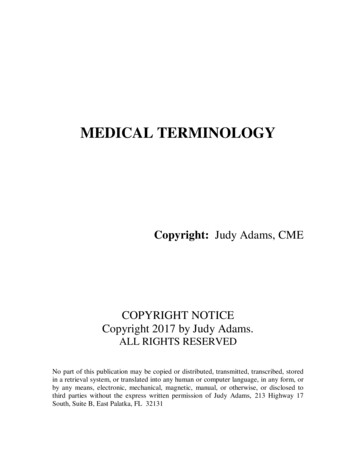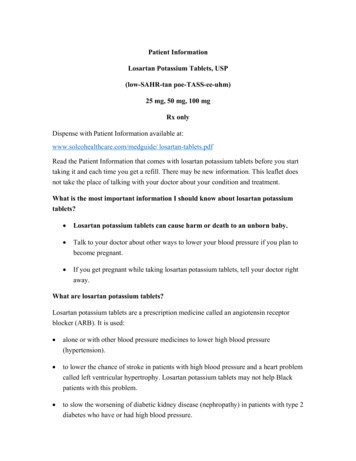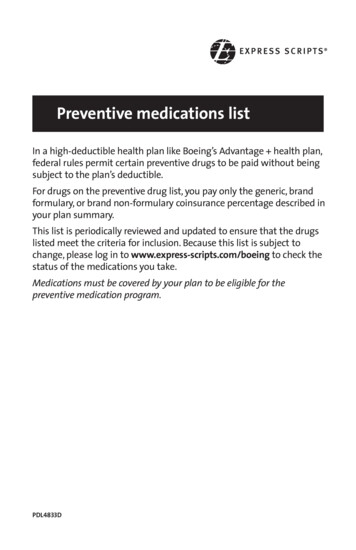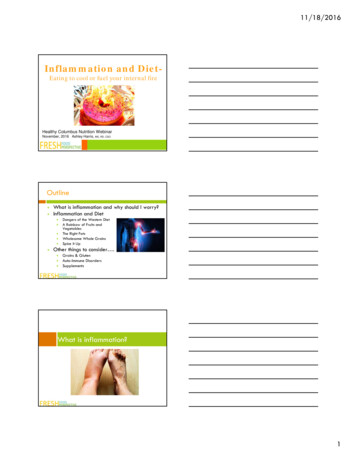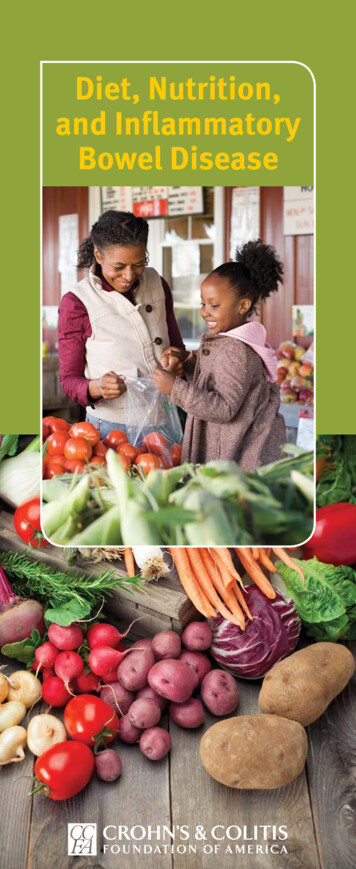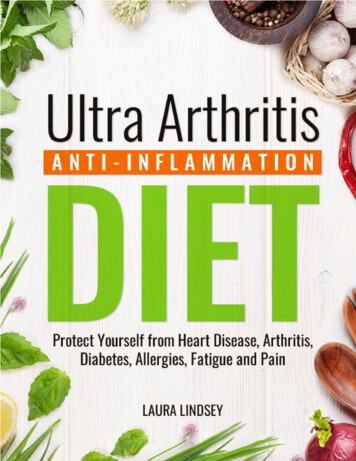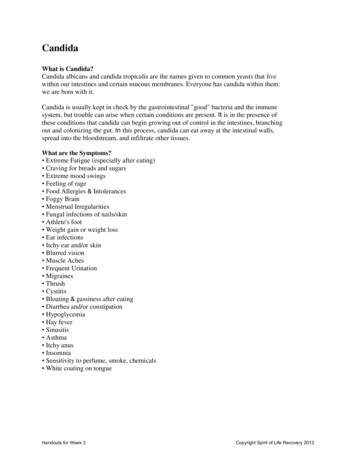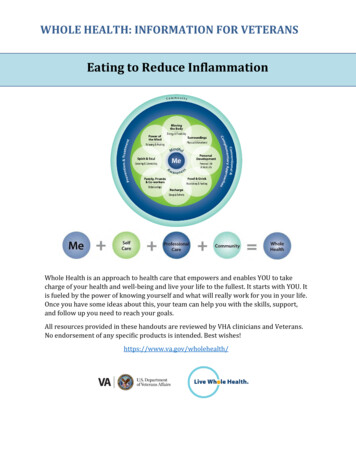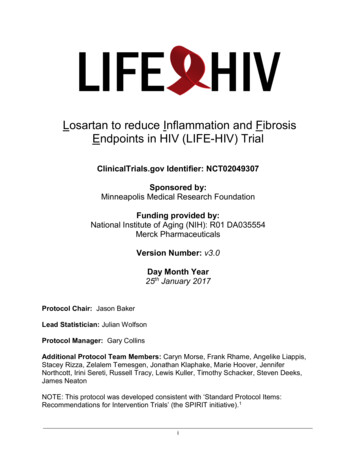
Transcription
Losartan to reduce Inflammation and FibrosisEndpoints in HIV (LIFE-HIV) TrialClinicalTrials.gov Identifier: NCT02049307Sponsored by:Minneapolis Medical Research FoundationFunding provided by:National Institute of Aging (NIH): R01 DA035554Merck PharmaceuticalsVersion Number: v3.0Day Month Year25th January 2017Protocol Chair: Jason BakerLead Statistician: Julian WolfsonProtocol Manager: Gary CollinsAdditional Protocol Team Members: Caryn Morse, Frank Rhame, Angelike Liappis,Stacey Rizza, Zelalem Temesgen, Jonathan Klaphake, Marie Hoover, JenniferNorthcott, Irini Sereti, Russell Tracy, Lewis Kuller, Timothy Schacker, Steven Deeks,James NeatonNOTE: This protocol was developed consistent with ‘Standard Protocol Items:Recommendations for Intervention Trials’ (the SPIRIT initiative).1i
Table of 6INTRODUCTION1BACKGROUND AND RATIONALEOBJECTIVES14METHODOLOGY4TRIAL DESIGNSTUDY POPULATIONELIGIBILITY CRITERIASTUDY MEDICATION INTERVENTIONOUTCOMESSTUDY VISIT SCHEDULESAMPLE SIZE CONSIDERATIONS4456789CLINICAL MANAGEMENT10ADMINISTRATION OF STUDY PROCEDURESSTUDY DRUG DOSE MODIFICATIONADHERENCE AND TOLERABILITYDATA COLLECTIONBLOOD SPECIMEN PROCESSINGCLINICAL LABSPLASMA BIOMARKERSIMMUNOLOGIC PHENOTYPESLYMPHATIC TISSUE ASSESSMENT101012121212121213SAFETY AND ADVERSE EVENTS13MEASURES TO REDUCE RISK FOR ADVERSE EVENTSADVERSE EVENT DEFINITIONSDOCUMENTING ADVERSE EVENTSADVERSE EVENT RELATIONSHIP TO STUDY DRUGREPORTING ADVERSE EVENTSPARTICIPANT W ITHDRAWALDATA AND SAFETY MONITORING PLAN13141415151616INTERIM ANALYSISFREQUENCY AND CONTENT OF DATA AND SAFETY MONITORINGDSMB MEMBERSHIP AND AFFILIATIONDSMB CONFLICT OF INTEREST AND PROTECTION OF CONFIDENTIALITYDSMB RESPONSIBILITIESANALYSIS PLAN161717171818REFERENCES20APPENDIX A: BLOOD/URINE SPECIMEN COLLECTION AND STORAGE1APPENDIX B: INFORMED CONSENT FORM (ICF) – WITH LN BIOPSY2APPENDIX C: INFORMED CONSENT FORM (ICF) – WITHOUT BIOPSY11ii
List of AbbreviationsThis list should be modified to include protocol-specific CAATSMARTTGF- TFAngiotensin Converting Enzyme InhibitorAdverse Event/Adverse ExperienceAcquired Immune Deficiency SyndromeAngiotensin Receptor BlockerAntiretroviral TherapyBasic Metabolic PanelBlood PressureClinical Coordinating CenterClinical Laboratory Improvement AmendmentsConsolidated Standards of Reporting TrialsCase Report FormCardiovascular DiseaseData and Coordinating CenterDiabetes MellitusData and Safety Monitoring BoardEvaluation of Subcutaneous Proleukin in a Randomized International TrialFood and Drug AdministrationFibroblastic Reticular Cell NetworkGood Clinical PracticeGlomerular Filtration RateHealth Insurance Portability and Accountability ActHuman Immunodeficiency VirusInformed Consent al New DrugInstitutional Review BoardLymph NodeLymphatic TissueNumber (typically refers to participants)National Institute of Aging, NIHNational Institute of Allergy and Infectious DiseasesNational Institutes of HealthOffice for Human Research ProtectionsOffice for Human Subjects ResearchPeripheral Blood Mononuclear CellsProtected Health InformationPrincipal InvestigatorPharmacokineticsQuality AssuranceQuantitative Image AnalysisQuality ControlSerious Adverse Event/Serious Adverse ExperienceStandard DeviationSubcutaneous, Recombinant, Human Interleukin-2 in HIV-Infected Patients with LowCD4 Counts Under Active Antiretroviral TherapyStrategic Management of Anti-Retroviral TherapyTransforming growth factor-betaTissue Factoriii
Protocol SummaryFull TitleLosartan to reduce Inflammation and Fibrosis Endpoints in HIVShort TitleLIFE-HIVClinical Trial Phase Phase 2IND SponsorNAConducted ByMinneapolis Medical Research Foundation and the Universityof MinnesotaPrincipalInvestigatorJason Baker, MD, MSLead StatisticianJulian Wolfson, PhDSample Size110 participantsStudy PopulationHIV positive patients 50 years on stable ART with HIV RNAlevel 200 copies/mL, CD4 count 600 cells/mm3, and noindication for angiotensin receptor blocker (or ACE-inhibitor)Accrual PeriodAnticipated enrollment 1 yearStudy DesignRandomize 110 participants 1:1 to receive losartan 100mg ormatched placebo daily (double-blind).Study Duration12 monthsInterventionLosartan 100mg versus matching placebo taken dailyPrimary ObjectiveTo evaluate the effects of losartan on systemic inflammation,as reflected in plasma levels of IL-6(Main) SecondaryObjectiveTo evaluate the effects of losartan on immune recovery, asreflected in peripheral blood CD4 T-cellsAdditionalSecondaryObjectivesEvaluating the effects of losartan on monocyte and T-cellactivation in blood, coagulation activation, recovery of T-cellsubsets in blood, adherence, tolerability, durability of findings,and lymphatic tissue assessments (in a subset of n 30) offibrosis, cellular activation, and T-cell homeostasisiv
Schematic of Study DesignStatement of ComplianceThis trial will be conducted in compliance with the protocol, International Conference onHarmonization Good Clinical Practice E6 (ICH-GCP), and the applicable regulatoryrequirements including U.S. Code of Federal Regulations applicable to clinical studies (45 CFR46 and 21 CFR 50, 56 and 21 CFR 312), directive 2001/20/EC on the approximation of thelaws, regulations and administrative provisions of the Member States relating to theimplementation of good clinical practice in the conduct of clinical trials on medicinal products forhuman use as amended by Commission Directive 2005/28/EC and NIAID Clinical Terms ofAward. All key personnel (all individuals responsible for the design and conduct of this study)have completed appropriate Human Subjects Protection Training.v
Protocol Version 3.0JAN 20171 INTRODUCTION1.1 Background and RationalePremiseContemporary antiretroviral therapy (ART)-treated HIV-infected patients are atincreased risk for cardiovascular disease (CVD), cancer, and other HIV-associated nonAIDS conditions. This excess risk is due to multiple factors, including a higher burden oftraditional risk factors, persistent inflammation and sub-optimal immune recovery afterstarting ART. Independent of HIV infection, older age increases risk for non-AIDSconditions and is itself associated with greater inflammation, reduced immune recoveryafter starting ART, and declining immune function (so called immune senescence). Safetreatments that target this pathology, beyond HIV treatment with ART, represent a majorunmet need for older HIV positive patients.The LIFE-HIV trial is a critical step to advance this field, prior to conducting a clinicaloutcome trial, by testing the effects of losartan treatment in a translational clinical trialthat will improve our understanding of non-AIDS disease pathogenesis. Ongoinginflammation contributes to excess CVD, cancer and disease in multiple organ systems.Specific to HIV pathogenesis, immune activation and associated inflammation alsodrives collagen deposition (i.e., fibrosis) in lymphatic tissue (LT), disrupting T-cellhomeostasis and limiting immune recovery, which further increases non-AIDS risk.Losartan is a safe, inexpensive, medication with immunomodulatory and anti-fibroticproperties, quite apart from lowering blood pressure. We will test the hypothesis thatlosartan will reduce inflammation and improve tissue fibrosis leading to additionalimmunologic recovery. These treatment effects have been demonstrated in uninfectedpopulations (e.g., those with renal or connective tissue diseases), but have not beentested among HIV positive patients where the mechanisms driving ongoing immuneactivation are somewhat unique to this disease.Scientific BackgroundThe Changing Spectrum of Morbidity and Mortality Among HIV Positive Patients:Antiretroviral therapy (ART) effectively and durably suppresses HIV replication, leads toimmune recovery (increasing CD4 T-cell counts) and prolonged life expectancy, andhas changed the spectrum of morbidity and mortality among HIV positive persons. 2-8Among well-treated patients with levels of HIV RNA below the level of detection, nonAIDS-related conditions are now a more common cause of morbidity and mortality thanAIDS.6, 9-11 The most relevant serious non-AIDS-related diseases in current clinicalpractice include atherosclerotic cardiovascular disease (CVD), cancer, liver disease,end-stage renal disease, bone disease and subclinical neurocognitive dysfunction. Ofthese, CVD and cancer constitute the vast majority of clinical events.5, 10-13What Contributes to Persistent Inflammation in Persons with ART-treated HIV Infection?HIV treatment with ART reduces activation of the immune response, including levels ofinflammatory cytokines, though most immunologic abnormalities persist compared to1
Protocol Version 3.0JAN 2017HIV uninfected persons.14, 15 The level of T-cell activation (e.g., CD38/HLA-DRexpression), reflecting adaptive immunity, predicts risk for AIDS16 and has beenassociated with CVD risk in cross-sectional studies.17, 18 More recent data demonstratethat innate immune activation also contributes to chronic inflammation.19-21 Activatedmonocytes (e.g., CD16 ) are more frequent with HIV infection.22, 23 The CD16 monocyte subset may be preferentially infected by HIV, demonstrate greater productionof cytokines, and is independently predictive of coronary artery calcium (CAC) amongHIV patients.24-26The precise mechanisms driving high level immune activation are not entirely clear, butappear to involve both a persistent anti-HIV response (even with HIV RNA at low levels)and a more generalized immune activation (e.g., cytokine release).15, 27-29 Potentialfactors specific to HIV infection that may account for excess inflammation include: a)destruction of gut epithelium, which leads to chronic translocation of bacterial products,b) dysregulated inflammatory responses to co-pathogens (e.g., cytomegalovirus), and c)loss of key regulatory response. Given that drivers of HIV-related inflammation aremulti-factorial and diverse, a treatment that down regulates the inflammatory responsemore broadly irrespective of the cause, like losartan, may be more likely to showefficacy.Pathologic Consequences of Ongoing Immune Activation For Immune Recovery:An important pathologic consequence of persistent immune activation is fibrosis oflymph node (LN) structures necessary for T-cell homeostasis.30 Ongoing immuneactivation stimulates production of TGF-ß that leads to fibrotic changes in theparafollicular T-cell zone of lymph nodes. LN fibrosis damages the fibroblastic reticularcell network (FRCn) that forms the skeletal anatomy of the T-cell zone, produces IL-7,and directs movement of T-cells within the LN. The loss of naïve T-cells furtherperpetuates the process through declines in lymphotoxin-β (from T-cells) that isessential for FRCn vitality. The vicious cycle leads to more reductions in IL-7 and T-celldepletion. LN collagen is therefore not only a cause of T-cell depletion but alsocontributes to incomplete immune recovery with ART via impaired survival of naïve Tcells. Losartan has been shown, both in vitro and in vivo, to inhibit TGF-ß and reverseexisting fibrosis.31-35 These treatment effects may be particularly important for older HIVpatients, given that normal aging leads to thymic involution and increased apoptosis,reducing circulating naïve T-cells.36, 37Study Outcomes: IL-6 and CD4 count Predict Non-AIDS Risk:Excess risk for non-AIDS conditions is due to multiple factors, including a higher burdenof traditional risk factors, but persistent immune depletion and ongoing inflammationdespite effective ART are key risk factors specific to HIV and are the focus of this trial.We have previously reported that CD4 T-cell count, including changes after startingART, predict risk for a composite of non-AIDS conditions (including CVD and cancer).38,39 Although risk for both AIDS and non-AIDS conditions decline with higher CD4 counts, this is more drastic for AIDS events.39, 40 Non-AIDS conditions are thereforemuch more common than AIDS events at moderate to higher (e.g., 500 cells/mm3)CD4 counts.41, 42 Mechanisms differ between distinct non-AIDS conditions, but2
Protocol Version 3.0JAN 2017associations between CD4 count and risk for these conditions has been reproduced inmultiple cohorts.6, 43-47Recent data from a number of epidemiologic studies have shown that inflammatorybiomarkers well validated in the aging and cardiovascular fields22, 48-51 are elevated withuntreated and (to a lesser degree) treated HIV infection,14, 52, 53 and predict risk for CVD,cancer, and non-AIDS mortality.54-60 Our group conducted a series of nested casecontrol and cohort studies, using data from 3 large HIV trials (SMART, ESPRIT, andSILCAAT), and determined that associations for risk of CVD, cancer, a composite ofserious non-AIDS events, and all-cause mortality was most robust for levels ofinterleukin-6 (IL-6).61-63 These associations are not attenuated by adjusting for HIV ortraditional CVD risk factors, are several-fold higher than reported in HIV-negativestudies, and persist over a median of 5.5 years of follow-up, making it an ideal riskmarker for a broad composite of non-AIDS conditions.54, 62, 64, 65Rationale for LosartanLosartan has well-established off-target, or non-blood pressure lowering, effects thatmay benefit HIV positive patients. Angiotensin-2 (AT-2), a potent vasoconstrictor, is akey regulator of the renin-angiotensin-aldosterone system (RAAS) that is also proinflammatory (through Nuclear Factor-Kappa B [NF- B] pathways) and pro-fibrotic (viatransforming growth factor beta [TGFβ1] induced connective tissue growth factor[CTGF] expression).31-35 ARBs (angiotensin receptor blockers) selectively block ATreceptor-1, mitigating the consequences for inflammation and fibrosis, but importantly,have fewer side effects than ACE-I. Tolerability to losartan (100mg) is consideredexcellent, with self-reported side effects no different than for placebo in clinical trials.66There exists a large body of evidence that ARBs (e.g., losartan) down-regulate immuneactivation. Angiotensin-2 induces activity of NF- B,67, 68 a transcription factor that, inpart, regulates immune activation and cytokine release (e.g., IL-6 and TNF-α).67, 69, 70Numerous (HIV uninfected) studies of ARBs or ACE-Is demonstrate reductions ininflammatory markers (e.g., IL-6, TNF-α, and CRP) via mechanisms both related to andindependent of angiotensin receptor blockade.71-75 In hemodialysis patients, losartanalso decreased monocyte activation (CD16 ) in vivo (to levels seen in healthy controls)and prevented monocyte activation (or CD16 expression) in vitro.76 In animal models,ARBs suppress transcription and release of IL-6 and other cytokines by monocytes.77-79Independent of reducing immune activation, losartan may improve T-cell homeostasisand immune recovery by reversing existing tissue fibrosis through a well characterizedmechanism of blocking TGF-ß at the level of phosphorylation of SMAD-2,3.31-35, 80-83 Inanimal models (of vascular, renal and cardiac fibrosis), losartan therapy inhibits TGF-ßactivity and improves histologic abnormalities.84, 85 In humans, losartan reduces urinarylevels of TGF-ß among those with transplant related kidney fibrosis,86, 87 reversedfibrosis and improved in cardiac function among those with myocardial fibrosis.88Losartan’s net effect is also to shift the balance of matrix metalloproteases and theirinhibitors in favor of tissue remodeling, which then reduces fibrosis.89-913
Protocol Version 3.0JAN 2017Finally, the 100mg dose of losartan was chosen: a) to maximize the treatment effect oninflammation and fibrosis,76, 86, 92, 93 b) due to the excellent safety profile and lack ofdifference in adverse events between 50mg and 100mg doses (data from 20 clinicaltrials),66 and c) due to the predictable CVD risk reduction through BP lowering.1.2 ObjectivesOur general goal is to evaluate the potential effectiveness of losartan (100mg daily) forreducing inflammation and improving immune recovery, given the potential for thesetreatment effects to reduce risk for long-term non-AIDS-defining complications amongolder HIV positive participants. Prior to conducting a clinical outcome trial, candidatetreatments must be studied among HIV positive patients given the unique pathogenesisdriving inflammation and disease risk. Study objectives then include: Primary Objective: Evaluate the treatment effects of losartan on systemicinflammation (Main) Secondary Objective: Evaluate the treatment effects of losartan on T-cellhomeostasis and immune recovery of T-cell population2 METHODOLOGY2.1 Trial DesignThe potential benefits of losartan (100mg daily) will be studied among HIV positiveindividuals over age 50 years whose CD4 counts remain 600 cells/mm3. Participants(n 120, 60 per group) will be randomized to receive losartan or matching placebo daily.After randomization, participants will start losartan (or placebo) at a dose of 50mg oncedaily, increasing to 100mg once daily at the 2-week study visit pending results of a week2 toxicity lab evaluation (see 2.4 below for criteria). Following month 1, participants willreturn for follow-up study visit procedures at months 3, 6, 9, and 12. A lymph nodebiopsy will also be performed at baseline and month 12 from a subset of participants(n 30).Changes from baseline in measures of inflammation, immune activation, immunerecovery and fibrosis within lymphatic tissues will be studied. The primary outcome willbe the average of IL-6 levels over 12 months, and the main secondary outcome will bechange in CD4 count in blood over 12 months.2.2 Study PopulationThe target population is HIV positive patients receiving effective treatment with ART andat low risk for AIDS defining complications. For these participants, non-AIDS defininglong-term complications (e.g., CVD and cancer) dominate the spectrum of morbidity andmortality. We will also focus on participants over age 50, as advanced age is4
Protocol Version 3.0JAN 2017associated with inflammation, poor immune recovery, and also increased risk for longterm complications such as CVD and cancer. Any antiretroviral medications can beused. Detailed inclusion and exclusion criteria are listed below. There are norestrictions on the use of concurrent mediations other than ARB or ACE-I, butparticipants with common diseases known to be pro-inflammatory will be excluded.2.3 Eligibility CriteriaInclusion Criteria HIV infection (verified by previous positive antibody or detectable HIV RNA level)Age 50 yearsReceiving continuous ART for 2 years; regimen changes acceptable if 4 weeksprior to screening when there is an ART class change (i.e., corresponding to either adeletion or addition of an ART class), or at anytime for an antiretroviral change thatis within an ART class.HIV RNA level 200 copies/mL for 1 year (1 measure 200 allowed if also 500and preceded and followed by one or more undetectable values)Blood CD4 T-cell count 600 cells/mm3Systolic blood pressure 110 mmHg (mean value, if 2 measures obtained)Estimated GFR 30 mL/min/1.73m2Do not anticipate starting (or stopping) statin or aspirin therapy during the studyFor women of child bearing potential, agrees to use a reliable form of birth controlExclusion Criteria Pregnancy or breast feedingA contra-indication to taking an ARB (e.g., cirrhosis, prior angioedema with ACE-I, oruse of drug with potential drug-interaction [e.g., rifaximin])A clinical indication for ARB or ACEi therapyCurrent treatment with ARB or medication with overlapping mechanism (e.g., ACE-Ior aldosterone antagonist)Treatment with immune-modulatory drugs within the past 6 monthsHepatitis C treatments (e.g., interferon, ribavirin) within the past 6 monthsSerum potassium 5.0 mmol/L within the past 3 monthsGrade 3/4 lab abnormality (from BMP, CBC or liver function panel)Invasive cancer in the prior year or receiving cancer treatment (not includingcarcinoma-in-situ or basal cell cancer of the skin)Cirrhosis or end-stage liver diseaseRheumatologic or chronic inflammatory disease (e.g., systemic lupuserythematosus, psoriasis, rheumatoid arthritis, vasculitis, sarcoidosis, Crohn’sdisease)Assessment by the clinical investigator that enrollment into the study could entailexcess risk to the participant, beyond what is intended or expected.BMI 40mg/kg2 for participants co-enrolled into the LN biopsy substudy.5
Protocol Version 3.0JAN 2017NOTE: For participants consented to co-enroll into the LN biopsy substudy, thefollowing approach based on BMI at screening visit will be applied:i.BMI 30: participants can be co-enrolled into LN substudy. A LN assessmentshould done upon consent (by MD, NP, or RN) to determine if the participanthas palpable LN in the inguinal region. Findings will be documented on theLN Biopsy Referral Form.ii.BMI 30-40: participants must have documentation of palpable LN in theinguinal region at the screening visit.iii.BMI 40: participants are not eligible for LN biopsy substudy.2.4 Study Medication InterventionAt baseline, participants will start losartan or matching placebo at 50mg daily. At 2weeks, side effects and blood chemistries (BMP) will be assessed. The dose oflosartan/placebo will increase to 100mg daily at the week 2 assessment if no toxicitiesor side effects are present that are attributable to study medication (see section 3.2below for specific study drug dose modification criteria). A similar repeat assessmentwill then be performed at month 1 to verify that the 100mg dose is tolerated.Randomization and BlindingEligible participants who consent to study procedures will be randomized 1:1 to receivelosartan or matching placebo, with stratification by clinical site and by whether theparticipant consents to undergo a LN biopsy. Treatment assignments will be generatedusing a permuted block randomization scheme. Sites will use a secure, on-line programto obtain treatment assignments. The program will also verify eligibility and theexistence of key baseline data. Treatment assignments will be verified and recorded ina dataset blinded to view by site staff.A bottle ID number (BID) unique to each bottle will be assigned to participants, andused by study staff to obtain the correct blinded study drug. Sites will not have access tothe treatment assignment linked to each bottle number, and bottle numbers will not beassigned in sequence.Blinding will occur at 3 levels: 1) treatment assignment will be blinded, 2) interim datasummaries will blinded to all but the unblinded statistician and 3) core lab staff will beblinded to treatment group. In the rare event that the blind must be broken, every effortwill be made to minimize the extent of the unblinding (for staff and participants) and anassessment of blinding will occur at the end of the study.Study Drug Production and DistributionActive losartan 50mg tablets and matching placebo will be provided and distributed byMerck Pharmaceuticals. From baseline to 1-month visit, participants will take one 50mgtablet daily. When/if the study drug dose is increased to 100mg, participants will take 2x50mg tabs once daily (for 100mg). Study drugs will be provided in 100 count bottles.One bottle will be dispensed at baseline, and one additional bottle at the 1-month visit.Following this, 2 bottles will be dispensed at all subsequent visits (months 3, 6, and 9).Sites will order study drug from the DCC, which will communicate with Merck to ship6
Protocol Version 3.0JAN 2017drug to sites. Merck will provide the DCC with the key linking the BID (unique to eachbottle) with whether the contents are active losartan or matching placebo. The DCC willthen instruct sites which bottle(s) to dispense to patients based on the BID.Risks Associated with Study DrugLosartan is approved by the FDA and used to treat high blood pressure. Possible sideeffects of losartan include dizziness, lightheadedness, headache, fatigue, cough, upsetstomach, vomiting, diarrhea, sore throat, fever, sweating, fast heart rate, chest pain,weakness, anemia, allergic reaction and kidney damage. In clinical studies, most ofthese side effects were no more common than what was experienced with placebomedication. Participants will undergo a side effect assessment at each visit (see casereport form and protocol implementation manual for ‘symptom check list’).Losartan should not be used during pregnancy. If a developing fetus is exposed tolosartan, injury or even death may result. For this reason, pregnancy is an exclusioncriterion and any pre-menopausal women of child bearing potential must be willing touse birth control during the study.2.5 OutcomesPrimary Outcome IL-6 plasma levels: change from baseline over 12 monthsMain Secondary Outcome CD4 T-cell count in blood: change from baseline over 12 monthsAdditional Secondary Outcomes Adherence Tolerability and side effects Monocyte activation immune-phenotyping (e.g., CD14 /CD16 ) Systemic inflammatory biomarkers (e.g., sCD14, sCD163, TNF-α, sTNFr-1, IL-6r,high sensitivity C-reactive protein) Coagulation activity (e.g., D-dimer levels) T-cell activation and senescence phenotypes in blood Recovery of CD4 T-cell subsets (e.g., naïve) in blood HIV-specific T-cell responses Plasma biomarkers of fibrosis (e.g., hyaluronic acid) Lymphatic Tissue fibrosis (LN biopsy substudy) Lymphatic Tissue cellular immune activation (LN biopsy substudy) Lymphatic Tissue T-cell homeostasis (LN biopsy substudy) Frailty assessment (including 5 components: unintentional weight loss, physicalinactivity, exhaustion, weak grip strength and slow walk)7
Protocol Version 3.0JAN 20172.6 Study Visit ScheduleParticipants will be screened and, if eligibility criteria are met, will be randomized at thebaseline visit to start active study drug or matched placebo (blinded). Randomizationmust occur within 90 days of all screening labs. NOTE: the 90-day screening torandomization window applies to all participants, both those co-enrolled into the LNbiopsy substudy and those not co-enrolled.Baseline laboratory evaluation must occur within 30 days of randomization. Forparticipants enrolled in the LN biopsy substudy, baseline labs cannot be drawn withinthe 7 days following the biopsy procedure. A LN biopsy specimen must be obtainedprior to randomizing the participant into the LN substudy. If a biopsy procedure isattempted but a LN specimen is not obtained at baseline, the participant will still beeligible to be randomized into the main study (but not the LN substudy). NOTE: thebiopsy procedure may occur after the baseline labs are obtained but still prior torandomization.After screening and baseline visits, participants will start losartan 50mg daily (orplacebo) and return for a lab draw to assess toxicity (BMP only) at week 2. At the week2 visit (after toxicity lab results return), participants will increase to losartan 100mg daily(or placebo) if they meet criteria based on results from the 2-week assessment (seesection 2.4 above). Subsequent study visit procedures will occur in the context of visitsat months 1, 3, 6, 9, and 12. For participants enrolled in the LN biopsy substudy, month12 visit labs cannot be drawn within the 7 days following the month 12 biopsy procedure(NOTE: the biopsy procedure may occur after the month 12 labs are obtained).Participant should continue to take study medication until all study visits are completed;for participants enrolled in the LN biopsy substudy this includes BOTH the month 12biopsy as well as the month 12 labs.The target visit window for each study visit is guided by anticipated study drug quantitythat the participant will have at the time. For week 2 and month 1, this corresponds to a14-day target window (or /- 7 days). Corresponding target windows for month 3, 6, 9,and 12 study visits are 32 days (or /- 16 days).NOTE: the ‘actual’ visit window for months 3, 6, 9, and 12 will be /- 42 days (i.e., nogaps between visits where participants would not be in a visit window), but if 16daysadditional study drug should be dispensed to the participant—consistent with makingevery effort to capture study visit data while keeping participants on study drug.The visit schedule is outlined in the table below. Patients will be fasting for all blooddraws (except screening).Toxicity labs and a clinical assessment will be ascertained as part of follow-up studyvisits. If clinical labs (e.g., HIV RNA level, CD4 count, BMP, hepatic panel, and CBC)are available as part of routine clinical monitoring during the study visit window, theseresults may be used in place of repeating clinic labs at the study visit. If new symptomsdevelop that may be related to study medications, the site study investigator is to be8
Protocol Version 3.0JAN 2017notified within 24 hours and a clinical determination is to be made whether additionaltoxicity labs and/or adherence requires assessing.BaselineWeek 2Month 1Month 3Month 6Month 9Month 12Informed consent and eligibility criteriaRandomizationScreeningTable 2: Study outcomes and visit nical AssessmentsAdherenceSide Effects (subjective including symptom check list)Toxicity labs (BMP)Toxicity labs (CBC and hepatic panel)HIV RNA levelHep Bs Ag & Hep C Ab (results within 1 year acceptable)*Lipid panel (results within 1 year acceptable)Pregnancy test (during f/u for women of childbearing potential)Blood Outcome MeasuresIL-6 levels (plasma)CD4 T-cell count (blood)Inflammatory, coagulation and fibrosis plasma biomarkersMonocyte and T-cell ImmunophenotypingFunctional AssessmentFrailty criteria: unintentional weight loss, exhaustion, physicalin
Antiretroviral therapy (ART) effectively and durably suppresses HIV replication, leads to immune recovery (increasing CD4 T-cell counts) and prolonged life expectancy, and has changed the spectrum of morbidity and mortality among HIV positive persons.2-8 Among well-treated patients with levels of HIV RNA below the level of detection, non-

